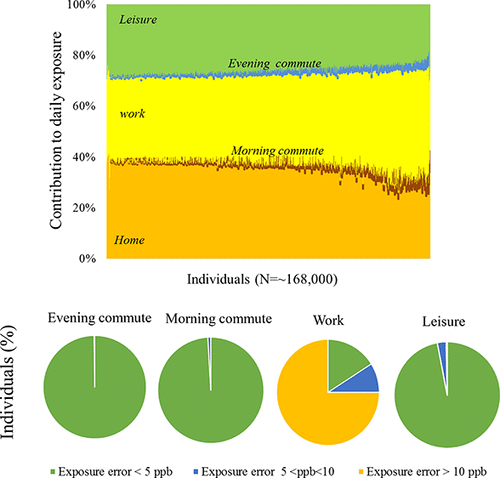当前位置:
X-MOL 学术
›
Environ. Sci. Technol.
›
论文详情
Our official English website, www.x-mol.net, welcomes your feedback! (Note: you will need to create a separate account there.)
Impacts of Personal Mobility and Diurnal Concentration Variability on Exposure Misclassification to Ambient Pollutants
Environmental Science & Technology ( IF 11.4 ) Pub Date : 2018-03-08 00:00:00 , DOI: 10.1021/acs.est.7b05656 Rakefet Shafran-Nathan 1 , Yuval 1 , David M. Broday 1
Environmental Science & Technology ( IF 11.4 ) Pub Date : 2018-03-08 00:00:00 , DOI: 10.1021/acs.est.7b05656 Rakefet Shafran-Nathan 1 , Yuval 1 , David M. Broday 1
Affiliation

|
Appreciating the uncertainty margins of exposure assessment to air pollution requires good understanding of its variability throughout the daily activities. This study describes a modeling framework for estimating exposure to air pollutants for a representative sample of working Israeli adults (N ∼ 168 000) for which both the residence and workplace addresses were available. Individual daily trajectories were simulated by accounting for five generic daily activities: at home, at work, while in commute from home to work and back, and during out-of-home leisure activities. The integrated daily exposure to nitrogen dioxide (NO2) was estimated for each individual by tracking the daily trajectory through an NO2 concentration map, obtained using a dynamic and highly resolved dispersion-like model (temporal resolution, half-hourly; spatial resolution, 500 m). Accounting for the subjects’ daily mobility was found to affect their exposure more significantly than accounting solely for the diurnal concentration variability, yet a synergistic effect was noted when accounting for both factors simultaneously. Exposure misclassification varies along the day, with the work microenvironment found to contribute the most to it. In particular, regardless of the high concentrations encountered during the commute, their contribution to the integrated daily exposure is small due to the relatively short time spent in this activity by most people.
中文翻译:

个人流动性和昼夜浓度变化对暴露于环境污染物的误分类的影响
认识到空气污染暴露评估的不确定性裕度,需要对它在日常活动中的可变性有充分的了解。这项研究描述了估算暴露于空气污染物的工作以色列成年人的代表性样本(建模框架ň〜168 000)其中两个住所和工作场所的地址可用。通过考虑五种日常活动来模拟个人的日常轨迹:在家中,在工作中,在家上下班上下班时以及在户外休闲活动中。通过跟踪通过NO 2的每日轨迹来估算每个人的每日总二氧化氮(NO 2)暴露量浓度图,使用动态且高度解析的散布样模型(时间分辨率,半小时;空间分辨率,500 m)获得。发现考虑对象的日常活动性比仅考虑昼夜浓度变化对他们的接触影响更大,但同时考虑到这两个因素时,仍会产生协同效应。暴露错误分类在一天中会有所不同,其中发现工作微环境对其造成的影响最大。特别是,无论上下班途中遇到高浓度,由于大多数人花在此活动上的时间相对较短,因此它们对每日综合暴露的贡献很小。
更新日期:2018-03-08
中文翻译:

个人流动性和昼夜浓度变化对暴露于环境污染物的误分类的影响
认识到空气污染暴露评估的不确定性裕度,需要对它在日常活动中的可变性有充分的了解。这项研究描述了估算暴露于空气污染物的工作以色列成年人的代表性样本(建模框架ň〜168 000)其中两个住所和工作场所的地址可用。通过考虑五种日常活动来模拟个人的日常轨迹:在家中,在工作中,在家上下班上下班时以及在户外休闲活动中。通过跟踪通过NO 2的每日轨迹来估算每个人的每日总二氧化氮(NO 2)暴露量浓度图,使用动态且高度解析的散布样模型(时间分辨率,半小时;空间分辨率,500 m)获得。发现考虑对象的日常活动性比仅考虑昼夜浓度变化对他们的接触影响更大,但同时考虑到这两个因素时,仍会产生协同效应。暴露错误分类在一天中会有所不同,其中发现工作微环境对其造成的影响最大。特别是,无论上下班途中遇到高浓度,由于大多数人花在此活动上的时间相对较短,因此它们对每日综合暴露的贡献很小。



























 京公网安备 11010802027423号
京公网安备 11010802027423号